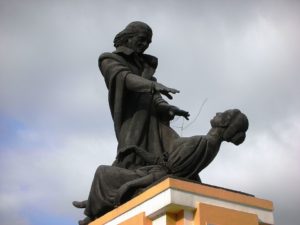Abbé de Faria

José Custódio de Faria, known as Abbé Faria (* May 30, 1756 in Candolim, Bardez, Goa, India; † September 20, 1819 in Paris, France), was a Portuguese priest, hypnotist and is considered one of the founders of dynamic psychiatry. Alongside Franz Anton Mesmer and the Marquis de Puységur, he was one of the most important hypnotists and magnetists in the history of this discipline.
Although almost forgotten today, many of his discoveries are still used in hypnosis today. Several authors used him as a literary figure and he was the first to establish a link between hypnosis and suggestion. He is also considered one of the founders of dynamic psychiatry. He is said to have only ever called out to people: “Go to sleep”, after fixing his palm, and then they fell into a trance. He said that the hypnotized person was actually the one to whom the hypnosis was attributed and not the other way round. According to his terminology, it was mainly women and hysterics who could be most influenced by hypnosis. He was the first to call the hypnotist a concentrateur, the hypnotized person a concentré and the state a concentration. He was also probably the first to work with the so-called “posthypnotic suggestion”: a previously hypnotized person performs things that he had previously been told under hypnosis, even though he is already awake again. Faria has also described himself as a Brahmin (Sanskrit: holder of sacred knowledge, supreme priest of Hinduism). His Indian origins enabled the hypnotist to study Indian mysticism and mythology and to incorporate some of this into his science and experiments.
Initiated in 1813 into the practice of animal magnetism by Marie Jacques de Chastenet, Marquis de Puységur, he quickly overtook his master, whose methods he extended and refined to the human race and opened a magnetizing practice in Paris.
In the same year, he gave a course on lucid sleep in Paris in which he criticized Franz Anton Mesmer’s theory of magnetic fluid.
His book on animal magnetism, The Cause of Lucid Sleep, which he publishes shortly before his death, begins with a letter to the Chastenet de Puységur.
His practice of hypnosis by suggestion brings him a considerable clientele as well as a swift reaction of discredit from conservatives, who call him a madman and a sorcerer. He spends the last years of his life as chaplain of a monastery.
From a scientific point of view, Faria brings to light the purely natural nature of hypnosis. He is the first to describe its methods and effects precisely and scientifically and anticipates the possibilities of hypnotic suggestion for the treatment of nervous disorders.
Among Faria’s disciples, we find the physician Alexandre Bertrand and General François Joseph Noizet.
We also find the influence of Faria in the first book on animal magnetism published by Ambroise-Auguste Liébeault, the director of the École de Nancy (On sleep and similar states – 1866).
Memoirs on somnambulism and animal magnetism
by General François Joseph Noizet [Auszug]
1814, on his return from a Hungarian prison in Szeged after the announcement of peace,
I heard of demonstrations of somnambulism given by Abbé Faria in the Rue de Clichy in Paris, in a building next to the old garden of the Tivoli.
I went there less out of curiosity than out of a desire to acquire specific ideas about animal magnetism.
There I saw an old man, tall and handsome, with half grayish-black hair, dark complexion, long face, hooked nose, large, bulging eyes, a handsome horse’s head, as I thought at the time.
I found out he was an Indo-Portuguese priest from Goa. Many distinguished members of the aristocracy were present, as well as several young cavalry officers; thirty to sixty persons in all who had paid three francs for admission.
The conference began with a monotonous and tedious reading of a manuscript in which the author explained his system.
He explicitly pointed out that the results he produced were not dependent on him, but entirely on the client, whose conviction was the only thing that mattered to get all the results.
He repeatedly emphasized that neither the devil nor animal magnetism were in any way involved in the phenomena produced.
Finally, after half an hour during which the audience waited impatiently, the experiments began. He was assisted by a cleaning lady and one or two regulars with whom he induced somnambulism with verbal instructions only.
He then selected three, four, five or more members of the audience with whom he tried to achieve similar results.
He made them sit comfortably, asked them to think about sleep and look at him,
while staring at them from a distance with his wide eyes, showing them the back of his raised hand, taking a few steps forward, then suddenly lowering his arm in front of them and commanding them to sleep soundly. Sometimes, but not often, he would approach them and press his finger to their foreheads while repeating the command: Sleep!
At least three times out of five, I’ve seen this technique succeed in less than a minute.
I even submitted to his approach, but he only managed to paralyze my eyelids, preventing me from opening my eyes until he commanded me to do so.
I brought him a rather delicate, young law student who fell asleep during Faria’s first attempt, talked like all somnambulists do, but was so embarrassed when he woke up that he refused to see the abbot again and even refused to submit to a few tests I wanted to perform. Since he lived with a relative of mine who was also studying law, I was able to determine by placing my hand on his forehead for a moment while he slept naturally that even if he didn’t wake up at night, he was indeed a natural somnambulist.
